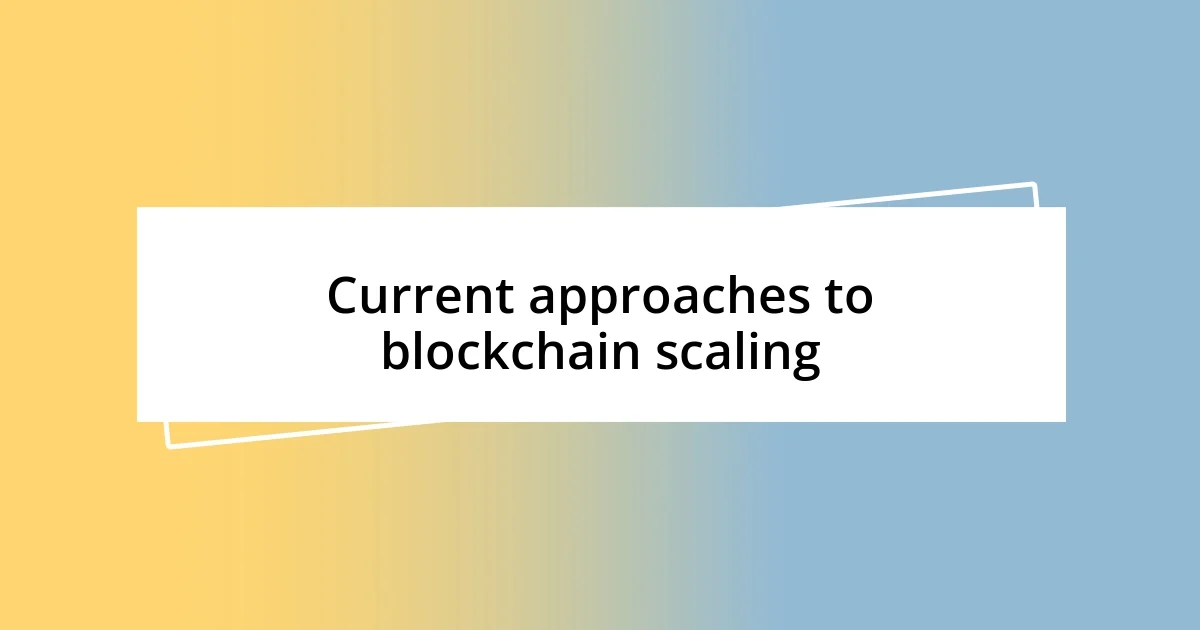Key takeaways:
- Blockchain scalability issues, rooted in consensus mechanisms and transaction limitations, directly affect user experience and real-world applications.
- Key scaling solutions include layer two technologies, sharding, and interoperability, which aim to enhance transaction speed and capacity without compromising security.
- Future trends point towards increased interoperability between blockchains, AI integration for optimizing performance, and community-driven governance to shape scalability advancements.

Understanding blockchain scalability issues
Scalability issues in blockchain are at the heart of its ability to handle increasing transaction volumes effectively. I remember the first time I saw a blockchain network struggle during high demand; transactions slowed to a crawl, and it felt like watching a bustling city get choked by traffic. It raises an important question: How can a technology built for decentralization face such fundamental limitations?
On a broader scale, these issues stem from the very design of many consensus mechanisms. For example, Bitcoin uses a proof-of-work system that prioritizes security but can be painfully slow during peak times. This makes me wonder if there’s a way to find balance; is it possible to have a scalable, fast, yet secure blockchain?
Delving deeper, the cost of transactions often shoots up when scalability is an issue, pushing users to rethink their engagement with blockchain technology. I recall when I had to wait several hours for a transaction to confirm, which was frustrating and made me reassess the role of blockchain in my financial activities. It’s a powerful reminder that scalability isn’t just a technical hurdle; it’s a vital aspect that affects real-world applications and user experiences.

Reasons behind scalability challenges
When I reflect on the reasons behind blockchain scalability challenges, I can’t ignore the fundamental trade-offs associated with consensus mechanisms. Take Ethereum’s proof-of-stake model, for instance; while it aims to optimize speed and energy efficiency, it still grapples with network congestion during high-traffic periods. I remember a time when I tried to interact with a decentralized application only to find the fees skyrocketing, making me reconsider whether these platforms would truly fit my needs. It’s clear that trade-offs exist, impacting both usability and cost.
- Transaction Limitations: Block size and time limitations can restrict the number of transactions processed in a given time frame.
- Network Congestion: Increased user activity can overwhelm the system, leading to delays and heightened fees.
- Consensus Mechanisms: Different types of mechanisms, like proof of work or proof of stake, influence speed, security, and overall network performance.
- Decentralization Level: Striking a balance between decentralization and efficiency can create friction in scaling solutions.
- Resource Constraints: Limited computing power and bandwidth can impede the network’s ability to process transactions smoothly.
As I ponder these challenges, I can’t help but feel a sense of responsibility in advocating for improvements. The potential for blockchain technology is immense, but it often feels just out of reach when these scalability issues hit close to home, impacting my day-to-day transactions and experiences.

Key concepts in scaling solutions
When diving into the key concepts of scaling solutions, one of the most crucial elements is the method of increasing throughput without compromising the core principles of blockchain. I recall discussing this with a tech-savvy friend, who emphasized that many scaling solutions, like layer two protocols, offer a way to manage a larger volume of transactions while still benefiting from the security of the main chain. It felt reassuring to see how innovation could pave the way for an efficient, user-friendly experience.
Another essential concept involves sharding—a promising technique that divides a blockchain network into smaller pieces or “shards” to allow parallel processing. When I first learned about sharding, it struck me as a fascinating approach. It brought to mind a bustling restaurant, where splitting the customers between several tables eased wait times significantly. I remember feeling hopeful that implementing sharding could alleviate pressure points in heavily congested networks, ushering in a new era of scalability.
Lastly, understanding the role of interoperability in scaling solutions cannot be overlooked. Many blockchains today are isolated, creating barriers that hinder their full potential. I experienced this firsthand while trying to transfer digital assets between different platforms; it was a convoluted and frustrating process. By developing interoperability standards, we can connect these ecosystems, allowing for seamless transactions and greater scalability across diverse networks.
| Scaling Solution | Description |
|---|---|
| Layer Two Solutions | Enhances transaction capacity by building on top of the main blockchain. |
| Sharding | Divides the blockchain into smaller sections to enable simultaneous processing. |
| Interoperability | Connects different blockchain networks for ease of asset transfer. |

Current approaches to blockchain scaling
When I look at the current approaches to blockchain scaling, one that often comes to mind is the use of layer two solutions. Recently, I had a moment of clarity while exploring a popular payment channel, and it impressed me how these structures can offload transactions from the main chain. It felt like finally finding a shortcut through that frustrating construction work during rush hour—now I could send funds much faster without the congestion that usually bogs down my transfers.
Another interesting approach is the implementation of sidechains. I remember hearing about sidechains for the first time during a blockchain seminar. It struck me as a practical way to expand capabilities and experiment without impacting the main blockchain. The examples shared showed how developers could test new features in a safer environment, avoiding the pitfalls of the main chain. Have you ever wished for a trial run before committing? That’s precisely what sidechains offer!
Then there’s the concept of state channels. I’ll never forget engaging in a spirited discussion with fellow enthusiasts about their potential. Imagine being able to conduct numerous transactions off the main chain and then closing it all in one go. I find that incredibly efficient and exciting—turning the mundane into something quite exhilarating! It’s this level of innovation that gives me hope for the future; finding ways to seamlessly handle transactions has the power to transform the blockchain landscape for users like you and me.

Evaluating layer one solutions
Layer one solutions are fundamental because they directly address the scalability challenges inherent in blockchain technology. As I delved into various projects, such as Ethereum and Bitcoin, I noticed that the differences in consensus mechanisms play a significant role in their throughput capacity. For instance, I can’t help but feel impressed by Ethereum’s shift to Proof of Stake; it seems like a strategic move to improve scalability while promoting energy efficiency. Isn’t it remarkable how protocol upgrades can reshape the user experience?
During my exploration, I stumbled upon the concept of block size, which has been a point of contention among blockchain proponents. The Twitter debates I witnessed sparked my curiosity about the trade-offs involved in increasing block size: yes, it could lead to quicker transactions, but what about decentralization? I often wonder if sacrificing a bit of decentralization for speed is worth it. It reminds me of those tricky conversations we have in our smartphones about privacy versus convenience!
Additionally, experimenting with different layer one architectures has been illuminating. With various blockchains adopting unique approaches like delegated Proof of Stake or hybrid models, I began to appreciate the importance of tailor-fit solutions based on specific use cases. For example, when a friend implemented a small business solution on a less-congested chain, it struck me just how much these choices can impact user experience. This makes me think: are we ready to embrace a broader range of blockchains to cater to specific needs? I certainly believe that evaluating each layer one solution on its strengths and weaknesses is essential for realizing blockchain’s true potential.

Exploring layer two solutions
As I dove deeper into the world of layer two solutions, I found that one of the most fascinating aspects is the versatility they offer. For example, take the Lightning Network—it was a game changer for me when I first used it for microtransactions. The ability to send tiny amounts of Bitcoin for a cup of coffee made me realize just how practical blockchain can be in our everyday lives. What’s more thrilling than witnessing technology seamlessly blend into our daily routines?
What really caught my attention was how optimistic many developers are about these solutions. When I attended a blockchain workshop, someone excitedly shared their success in implementing a layer two scaling proposal. It was thrilling to see the collective excitement in the room as they discussed improved transaction speeds and reduced fees. It made me ponder: could this be the key to widespread adoption? I firmly believe that when we start addressing scalability issues in meaningful ways, the floodgates for new users and applications will open wide.
Layer two solutions also spark a sense of collaboration among users and developers, which I find particularly inspiring. I recall joining an online community where enthusiasts brainstormed different applications for state channels. The camaraderie was palpable as we all recognized the potential for these solutions to transform industries—not just finance, but gaming and supply chain management too. Don’t you get the feeling that we are still just scratching the surface of what’s possible with layer two technologies? I am genuinely excited to see how these innovations continue to evolve and shape the future of blockchain.

Future trends in blockchain scalability
Looking ahead, I’m struck by the growing emphasis on interoperability among blockchains as a key trend in scalability. When I experienced cross-chain swaps during a DeFi project, I realized how powerful it can be to operate seamlessly across different platforms. Isn’t it fascinating to think about a landscape where transactions are not bound by individual chains, creating a truly interconnected ecosystem?
Another compelling direction is the integration of artificial intelligence in scalability solutions. Recently, I stumbled upon a project that utilized AI to optimize transaction routing, which significantly reduced latency. It opened my eyes to the potential of combining advanced technologies to enhance efficiency—how cool is it to think that AI could learn the best ways to manage network congestion?
Moreover, I can’t help but feel excitement around the rise of community-driven governance models in blockchain. I remember participating in a governance vote that led to a significant scalability upgrade on a platform I follow. It made me appreciate how user input can directly influence development. Could this trend empower more people to take part in shaping blockchain’s future? I truly believe that engaging the community will drive innovation and ensure solutions resonate with real user needs.














